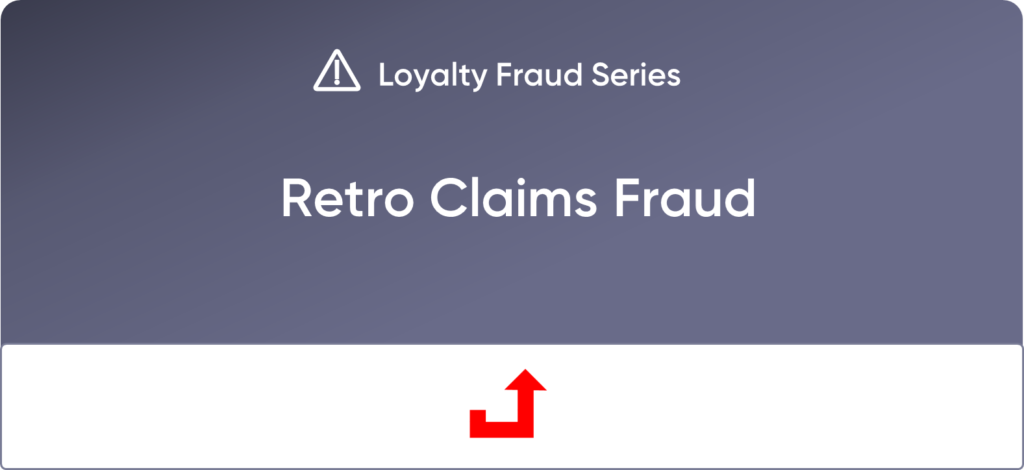
If you have been following our loyalty fraud series, you are probably thinking how many more ways can fraudsters take advantage of a loyalty program? Well, I have another instance of fraud for you to consider – retro (or retrospective) claims fraud. This involves a member claiming benefits for past purchases or activities they did not make.
Retro claims fraud scenarios
Here are several retro claims fraud scenarios which loyalty managers should be acutely aware of:
- Receipt manipulation
Scenario: A loyalty program member finds or is given a receipt from someone else’s purchase, then claims the purchase as their own to get benefits.
Example: A customer visits a restaurant and finds a discarded receipt on the table or in the trash. They use the receipt to submit a retroactive claim for loyalty points, pretending they made the purchase.
- Expired transaction claims
Scenario: A member submits claims for transactions that occurred outside the permissible window for claiming points.
Example: A member purchases items from a store six months ago but never collected loyalty points. Knowing the store’s policy allows retroactive claims within only three months, they alter the purchase date on the receipt to make it appear as if it was made within the valid timeframe.
- Claiming for others’ transactions
Scenario: The fraudster gathers transaction details from friends, family, or even online forums and submits claims for purchases they did not personally make.
Example: A member gets a hotel receipt from a friend who is not part of the loyalty program and submits it as their own transaction to claim points for the stay.
- False activity claims
Scenario: Members claim retroactive benefits for activities tied to promotions or bonus offers they did not participate in or flights and travel they cancelled.
Example: A retailer runs a promotion where double points are offered for in-store purchases over the weekend. A member who shopped online during that weekend but didn’t go in-store submits a claim, falsely stating they made an in-store purchase to receive the bonus points.
Risks
Retro claims fraud presents several critical risks that can undermine the benefits provided by the loyalty program.
Firstly, there is a financial risk. If fraudsters can submit multiple fraudulent claims, there is a financial cost to delivering the benefits which can rise exponentially if word of the vulnerability gets out.
Secondly, there is the operational risk. The influx of fraudulent claims significantly increases the workload of the customer services teams who are tasked with processing these claims.
Lastly, fraudulent claims skew program analytics, which can lead to misguided strategic decisions based on inaccurate data.
Mitigations for retro claims fraud
To address retro claims fraud, loyalty program operators should consider implementing several strategies.
The most effective mitigation is to eliminate retrospective claims entirely, removing the opportunity for this type of fraud.
If retro claims must be supported, it’s crucial to implement strict limitations. This includes limiting the number of claims allowed per account to minimise fraud exposure and imposing tight time restrictions on when claims can be made. Most airline programs, for instance, limit claims to within six months of the transaction, while quick-service restaurants (QSRs) typically set even shorter timeframes.
Implementing enhanced verification procedures for retro claims, potentially requiring additional documentation or proof of purchase, is another effective strategy. Deploying systems to detect unusual claiming patterns or suspicious activity allows for quick intervention.
Lastly, maintaining detailed logs of all retro claims is important for these fraud investigations.
Retro claims fraud examples
To prevent retro claims fraud, it is useful to see how vulnerabilities have unfolded in other industries to develop targeted prevention strategies.
Airline Industry
Numerous airline frequent flyer programs permit members to retroactively claim miles for past flights, rendering them susceptible to retro claims fraud. The aforementioned six-month claim window is a prevalent mitigation tactic in this sector.
Quick Service Restaurants (QSRs)
Fast food chains frequently offer loyalty programs allowing post-purchase point claims. Their abbreviated claim windows reflect the higher transaction frequency and lower individual transaction value characteristic of the industry.
Retail Sector
Certain retail loyalty schemes enable customers to input receipt codes after purchases in order to earn. Whilst convenient for customers who forget their loyalty cards, this feature can be exploited by fraudsters.
Secure your loyalty program
As loyalty program fraud continues to become more sophisticated, being proactive is crucial for program operators. For bespoke advice on protecting your loyalty program from retro claims fraud and other security threats, we encourage you to contact our team of experts. Our tailored solutions can help you implement robust security measures, mitigate risks, and ensure the long-term success of your loyalty initiative.
Acknowledgement
Thank you to Michael Smith, co-founder of the Loyalty Security Alliance and contributor to ‘Loyalty Programs: The Complete Guide’, whose expertise helped inform insights presented in this article.

